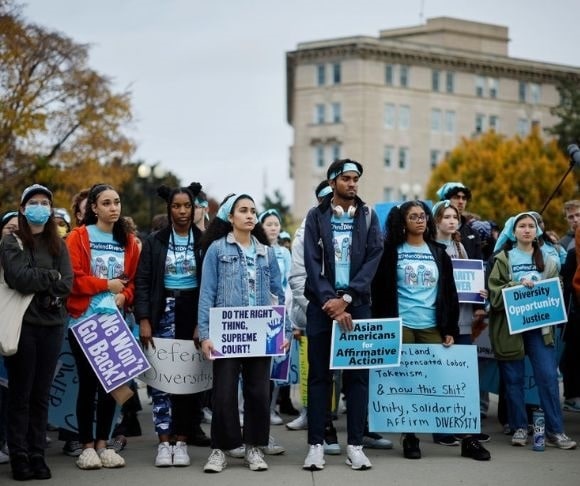Using race to decide whether someone will be accepted or denied admission to higher education was already illegal before Thursday, June 29. What’s changed is the Supreme Court ripped off its self-imposed blinders. Justices admitted affirmative action never became an elevated form of selection inclusive of race. Instead, by a vote of 6-3, they ruled it violates the 14th Amendment rights of whites and Asians, who were punished by the practice. The Court’s majority said the affirmative action plans failed all the tests applied against them and violated the Equal Protection Clause. Applicants classified as Asians, especially, will benefit from this decision, as they were subject to the worst discrimination.
Affirmative Action Is Out!
Students for Fair Admissions v. University of North Carolina and Students for Fair Admissions v. Harvard were the case names. The founder and president of Students for Fair Admissions, Edward Blum, said the ruling “marks the beginning of the restoration of the colorblind legal covenant that binds together our multi-racial, multi-ethnic nation.” He went on: “Ending racial preferences in college admissions is an outcome that the vast majority of all races and ethnicities will celebrate. A university doesn’t have real diversity when it simply assembles students who look different but come from similar backgrounds and act, talk, and think alike.”
Chief Justice John Roberts wrote the majority opinion. He was joined by Justices Clarence Thomas, Samuel Alito, Neil Gorsuch, Brett Kavanaugh, and Amy Barrett. Justice Gorsuch filed a concurring opinion joined by Thomas, as did Kavanaugh. Justice Sonia Sotomayor filed a dissenting opinion joined by Justices Elena Kagan and Ketanji Jackson. Jackson wrote in dissent as well, joined by Sotomayor and Kagan.
Presidential Pushback

Joe Biden (Photo by Win McNamee/Getty Images)
Naturally, the decision sparked a progressive backlash. President Biden took a break from his re-election campaigning to comment on the Court’s work in this case. He addressed reporters from the Roosevelt Room at the White House to denigrate the Supreme Court’s ruling. Biden said, “Discrimination still exists in America.” Then he repeated the line twice again. Why? Neither the Court’s majority nor any prominent opponent of affirmative action says it doesn’t. They say engaging in racial discrimination is never okay, even to remedy past discrimination.
While exiting the room, a reporter shouted to the president, “The Congressional Black Caucus said the Supreme Court has thrown into question its own legitimacy; Is this a rogue Court? Biden paused and answered before leaving, “It’s not a normal Court.”
Black Is the New Black
It turns out being black was about the best thing your application could say about you at Harvard. Better than higher grades or test scores. Robert’s opinion noted that the affirmative action programs failed because they are not highly focused with measurable objectives warranting the use of race, unavoidably employ race in a negative manner, involve racial stereotyping, and lack meaningful sunset times.
The principle dissent by Justice Sotomayor ran nearly 70 pages. She wrote, “In a society where race continues to matter, there is no constitutional requirement that institutions attempting to remedy their legacies of racial exclusion must operate with a blindfold.” And:
“Today, this Court overrules decades of precedent and imposes a superficial rule of race blindness on the Nation. The devastating impact of this decision cannot be overstated. The majority’s vision of race neutrality will entrench racial segregation in higher education because racial inequality will persist so long as it is ignored.”
Justice Thomas wrote separately in concurrence with the majority “to offer an originalist defense of the colorblind Constitution;… to clarify that all forms of discrimination based on race—including so-called affirmative action—are prohibited under the Constitution, and to emphasize the pernicious effects of all such discrimination.” Upon his graduation from Yale Law School – the country’s most prestigious – Thomas revealed that he was greeted with no eager and attractive job offers. His white colleagues were, and he blames affirmative action for discounting his degree because of the color of his skin. Thomas wrote:
“Meritocratic systems, with objective grading scales, are critical to that belief. Such scales have always been a great equalizer—offering a metric for achievement that bigotry could not alter. Racial preferences take away this benefit, eliminating the very metric by which those who have the most to prove can clearly demonstrate their accomplishments—both to themselves and to others.”
Justice Gorsuch, who Justice Thomas joined, wrote to mention the policies in question don’t just violate the 14th Amendment, as the Court’s majority has ruled, but also the Civil Rights Act of 1964. Gorsuch argued that questions about how much racial discrimination went on or the motivations for race-based decisions are moot because the law does not permit any analysis here:
“Instead, the law prohibits covered institutions from intentionally treating any individual worse even in part because of race. So yes, of course, the universities consider many non-racial factors in their admissions processes too. And perhaps they mean well when they favor certain candidates over others based on the color of their skin. But even if all that is true, their conduct violates Title VI just the same.”
 The Court concluded its opinion by saying that an applicant’s discussion of race or racism, may be considered by a school. But there was a warning, too: “Universities may not simply establish through application essays or other means the regime we hold unlawful today.”
The Court concluded its opinion by saying that an applicant’s discussion of race or racism, may be considered by a school. But there was a warning, too: “Universities may not simply establish through application essays or other means the regime we hold unlawful today.”
Don’t Get Cute …
“[A] student whose heritage or culture motivated him or her to assume a leadership role or attain a particular goal must be tied to that student’s unique ability to contribute to the university,” Roberts admonished progressive college bureaucrats. “In other words, the student must be treated based on his or her experiences as an individual—not on the basis of race.” Based on this decision, the courts will likely be crowded soon with cases challenging admissions schemes.




